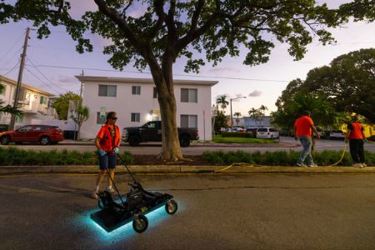Shining A New Light On Water Pollution
By Lorena Taboas

A collaborative study between the University of Miami College of Engineering and City of Miami Beach explores how ultraviolet light could help make local waters cleaner
Before the sun rose over Miami Beach, Helena Solo-Gabriele and a group of University of Miami College of Engineering students were already at work. In the predawn hours, a different kind of light filled the street as the bright blue beam of a UV machine moved through a quiet neighborhood near 73rd Street and Dickens Avenue.
The experiment, part of a years-long research collaboration between Solo-Gabriele, a professor of environmental engineering, and the City of Miami Beach, is testing whether enhanced street cleaning can help reduce bacteria in stormwater runoff before it flows into the city’s canals.
Elevated bacteria levels have been documented in the Park View Canal since April 2019. The levels are not unlike other urban canals through Miami-Dade. The University of Miami’s initiative began in 2022, after high readings persisted despite earlier efforts to identify the source. That year, Solo-Gabriele’s research team collected water samples from multiple locations and at different times within the canal. Their findings showed that the pollution was coming primarily from the streets and sidewalks. The continued contamination has kept residents under a no-contact advisory for the canal, where they once kayaked and paddleboarded.
The study also highlights the challenges facing urban canals and waterways, which were built for flood control rather than recreation. In contrast, water quality at nearby beaches is typically higher, with regular weekly testing by the Florida Department of Health and the presence of lifeguards to monitor conditions.
“The acceptable level for beaches is 70 bacteria per 100 milliliters, but we’ve measured levels at times above 24,000,” Solo-Gabriele said. “The bacteria we’re measuring, called enterococci, are fecal indicators and we can also use microbial source tracking markers to determine whether the bacteria are coming from dogs or birds.”
The most recent experiment compared three street-cleaning strategies: no cleaning, standard sweeping, and sweeping combined with UV light disinfection. Using a mobile Sterilaser UV-C machine retrofitted for outdoor use, the team disinfected each section of street and sidewalk. They then simulated rainfall over those areas to test the runoff for bacteria.
The data collected in the field is analyzed back at the College of Engineering, where civil engineering graduate student Mackenzie Howell processes the water samples.
“It’s been interesting to see how the data connects to real environmental impacts and how our results could be used to improve stormwater quality,” Howell said. “This project has definitely helped me build both technical and problem-solving skills while showing how research can lead to real solutions.”
The city’s goal is to use the data to help Park View Canal reach safe levels for public contact. Despite major infrastructure improvements, bacteria levels remain above recreational standards for beach bathing. The canal receives stormwater runoff from an 81-acre urban area and, because it is tucked within Miami Beach’s barrier island, has little natural water circulation. The slow-moving water traps pollutants and bacteria, allowing them to build up over time.
The city hopes that findings from Solo-Gabriele’s team, along with greater community awareness about proper pet waste cleanup, will help guide how often to sweep streets and whether to deploy UV disinfection in certain hot spots.
“We value our partnership with Dr. Solo-Gabriele and her team of students,” said Amy Knowles, Chief Resilience Officer for the City of Miami Beach. “They have provided a level of innovation and analysis that our community really appreciates as we work to improve water quality which is a common challenge in urban areas.”
The project reflects a growing effort to combine engineering research with community action to provide real-world solutions in the South Florida region.
“This is the first time that UV light is used to evaluate the disinfection of street surfaces,” said Solo-Gabriele. “Results open the door for a new technology that can be used to improve water quality within our local communities and in other communities that suffer from excessive bacterial levels within their waterways.”
Source: University of Miami
